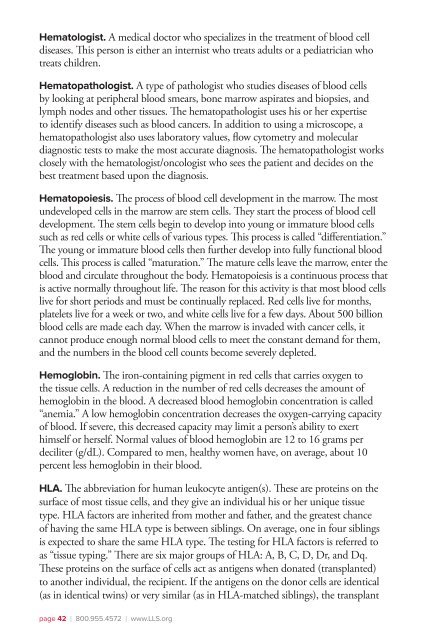Acute Myeloid Leukemia - The Leukemia & Lymphoma Society
Acute Myeloid Leukemia - The Leukemia & Lymphoma Society
Acute Myeloid Leukemia - The Leukemia & Lymphoma Society
- No tags were found...
You also want an ePaper? Increase the reach of your titles
YUMPU automatically turns print PDFs into web optimized ePapers that Google loves.
Hematologist. A medical doctor who specializes in the treatment of blood celldiseases. This person is either an internist who treats adults or a pediatrician whotreats children.Hematopathologist. A type of pathologist who studies diseases of blood cellsby looking at peripheral blood smears, bone marrow aspirates and biopsies, andlymph nodes and other tissues. <strong>The</strong> hematopathologist uses his or her expertiseto identify diseases such as blood cancers. In addition to using a microscope, ahematopathologist also uses laboratory values, flow cytometry and moleculardiagnostic tests to make the most accurate diagnosis. <strong>The</strong> hematopathologist worksclosely with the hematologist/oncologist who sees the patient and decides on thebest treatment based upon the diagnosis.Hematopoiesis. <strong>The</strong> process of blood cell development in the marrow. <strong>The</strong> mostundeveloped cells in the marrow are stem cells. <strong>The</strong>y start the process of blood celldevelopment. <strong>The</strong> stem cells begin to develop into young or immature blood cellssuch as red cells or white cells of various types. This process is called “differentiation.”<strong>The</strong> young or immature blood cells then further develop into fully functional bloodcells. This process is called “maturation.” <strong>The</strong> mature cells leave the marrow, enter theblood and circulate throughout the body. Hematopoiesis is a continuous process thatis active normally throughout life. <strong>The</strong> reason for this activity is that most blood cellslive for short periods and must be continually replaced. Red cells live for months,platelets live for a week or two, and white cells live for a few days. About 500 billionblood cells are made each day. When the marrow is invaded with cancer cells, itcannot produce enough normal blood cells to meet the constant demand for them,and the numbers in the blood cell counts become severely depleted.Hemoglobin. <strong>The</strong> iron-containing pigment in red cells that carries oxygen tothe tissue cells. A reduction in the number of red cells decreases the amount ofhemoglobin in the blood. A decreased blood hemoglobin concentration is called“anemia.” A low hemoglobin concentration decreases the oxygen-carrying capacityof blood. If severe, this decreased capacity may limit a person’s ability to exerthimself or herself. Normal values of blood hemoglobin are 12 to 16 grams perdeciliter (g/dL). Compared to men, healthy women have, on average, about 10percent less hemoglobin in their blood.HLA. <strong>The</strong> abbreviation for human leukocyte antigen(s). <strong>The</strong>se are proteins on thesurface of most tissue cells, and they give an individual his or her unique tissuetype. HLA factors are inherited from mother and father, and the greatest chanceof having the same HLA type is between siblings. On average, one in four siblingsis expected to share the same HLA type. <strong>The</strong> testing for HLA factors is referred toas “tissue typing.” <strong>The</strong>re are six major groups of HLA: A, B, C, D, Dr, and Dq.<strong>The</strong>se proteins on the surface of cells act as antigens when donated (transplanted)to another individual, the recipient. If the antigens on the donor cells are identical(as in identical twins) or very similar (as in HLA-matched siblings), the transplantpage 42 I 800.955.4572 I www.LLS.org
















